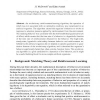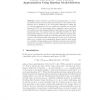536 search results - page 29 / 108 » Residual Algorithms: Reinforcement Learning with Function Ap... |
AGENTS
2001
Springer
14 years 5 days ago
2001
Springer
This paper describes Icarus, an agent architecture that embeds a hierarchical reinforcement learning algorithm within a language for specifying agent behavior. An Icarus program e...
ECAL
2005
Springer
14 years 1 months ago
2005
Springer
An evolutionary reinforcement-learning algorithm, the operation of which was not associated with an optimality condition, was instantiated in an artificial organism. The algorithm ...
ICCBR
2009
Springer
14 years 2 months ago
2009
Springer
This work presents a new approach that allows the use of cases in a case base as heuristics to speed up Reinforcement Learning algorithms, combining Case Based Reasoning (CBR) and ...
PKDD
2009
Springer
14 years 2 months ago
2009
Springer
Abstract. Feature selection in reinforcement learning (RL), i.e. choosing basis functions such that useful approximations of the unkown value function can be obtained, is one of th...
ICML
2003
IEEE
14 years 28 days ago
2003
IEEE
Reinforcement learning has been used for training game playing agents. The value function for a complex game must be approximated with a continuous function because the number of ...


